 |
| Satellite |
<update>
I discovered that Bedford Park does have a residential area sandwiched between a corn product plant and railroad yards. So the industries do have to support a small park, elementary school, police department, public library, parkway trees and street maintenance. The 2020 census was a population of 602.
</update>
"The Belt’s Clearing Yards span a 5.5 mile distance among 786 acres, supporting more than 250 miles of track." "Owner lines, as well as several other
railroads, bring trains to the Belt Railway to be efficiently separated,
classified, and re-blocked for cross-country departure. The Belt
Railway currently dispatches on a service-driven basis more than 8,400
rail cars per day. At Clearing Yards, employees are able to classify
between 40 and 50 miles of train consists every 24 hours." (BRCabout)
I include the 1938 aerial photo that shows that industry has filled the blocks north of the yard, but south of the yard is still undeveloped. I included the bottom of Midway Airport in the upper-right corner.
Cicero Avenue has a long bridge over the yards. The traffic was stop-and-creep as I headed South. Since I had to make a left-hand turn at the end of the bridge, I was not in the right-most lane so this is the best picture I got.
I then parked the car and walked South on the west side of the bridge. Unlike the Tollway Authority, the hand rails were high enough that I felt safe. And it is a good thing the sidewalk is wider than the Tollway Authority's design because this pedestrian crossing is used. I saw bikes and electric chairs, as well as regular pedestrians.
The train in the foreground is being shoved over the west hump that is under the control tower in the middle of the photo. Note that the building on the right is the big white building in the above historic photo. And there is an airplane above it that is on approach to Midway Airport. You can see a lot of planes when you railfan on the south side of Chicago. I include a similar shot that I took later to record how slowly they hump the cars. Note that the 3 flatcars have moved just a few car lengths in 34 seconds.
Closer to the middle of the bridge, I took a picture with a wide-angle lens to get an overview. I also added a red line above the three flat cars to note their progression. And I continue to crop out the sky and, sometimes, the foreground.
Then I took pictures of the north and south sides with a normal lens to get a more accurate perspective of the depth of the yard. In the north photo you can see some of the industry that fills the blocks along the yard.
The remaining information until "Update:" is from a Sept. 2006 article in Progressive Railroading.
They're also modernizing infrastructure and equipment, such as installing remote-controlled switches and implementing variable speed humping with help from Cattron-Theimeg Inc. and GE - Transportation.
If they execute the plan, they'll consistently process more than 3,000 cars within a 24-hour dwell period instead of the 26 or 27 hours the BRC has been averaging at times to switch 2,700 to 2,800 cars, managers say.
Re-humps because of incorrect humps are at about 15 percent of humps, which management considered too high. I was surprised that there were any incorrect humps. What goes wrong?
Update:
The following would be facing East. And it is just one of the two hump yards. The fact that there is no run-through tracks around it reminds me that in the first half of the century, freight moved in boxcars and had to be reclassified at the railroad yards. Probably only unit trains were stock-car trains, and they would have been taken directly to the stockyards rather than to this yard. It appears that his was taken before Midway Airport was built (dedicated in 1927) and shows that they did go way out of town to avoid property taxes.
Scott Malek posted some photos of Clearing Yard during 1991-93.
John's photo above was back when the engine servicing facilities from the steam era were still standing.
The Google link above shows the remnants of the roundhouse. I save the image because who knows if they might clean up the land some day.
Sean Graham-White posted two photos with the comment: "Before AEI, the BRC had cameras along primary entrances/exits to Clearing Yard to record reporting marks of each train. Clerks would verify them to train reports that had been advanced from other railroads to ensure accurate car reporting and billing. Bedford Park, IL 7/1/95"
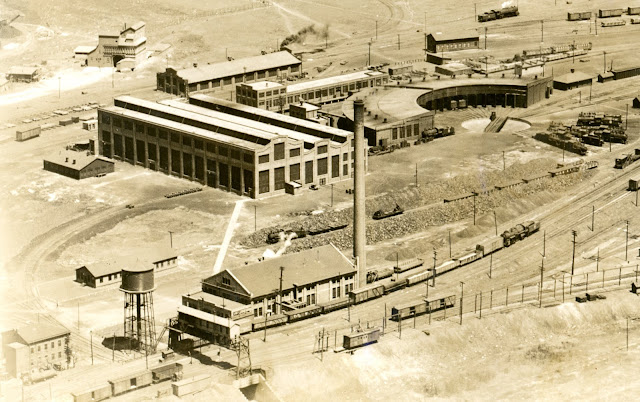 |
| Tommy Hill posted Belt Railway of Chicago Clearing Yard abt. 1920's |
Carload freight in general is a small fraction of what it was at the turn of the 20th Century because of trucks, airplanes, and intermodal and unit trains. But the two hump yards in this complex remain busy because most of the trunk railroads have converted their own classification yards to intermodal yards. For example, BNSF brings mixed freight trains from Galesburg directly to this yard and IHB's yard. Their Clyde and Corwith Yards are now intermodal yards.
 |
| Cean Graham-White posted BRC Clearing Yard & CSXT Bedford Park Intermodal 11/13/23 |
;;;
 |
| Viral Media posted BRC Clearing Yard Tower Robert Bender: This is my post - reposted without credit.. @Railroad_Journal |
 |
| Glen Koshiol posted A look inside the BRC Clearing shops finds three different models in various states of repair and rebuilding. 603 getting an overhaul and paint along with what I think was the 506. That 490 class was getting new wheels, those are tires with the new axles behind it. The BRC was the last to still use tires on locomotives well into the 80's. You can see the machine that presses them on after heating the tires. This shot was taken between hostling duties on the third shift during the downturn in traffic in the early 80's, my shot, 11/24/82. Jim Polaski: I was told they keep or had kept a steam crane there for a long time...any truth? Chip Kruminas: Jim Polaski When I hired out in the shop one of my first jobs was to go down to the Derrick shed and keep a fire going and check the water in the site glass.Also fill the coal bunker and clean the ash pan. It was a Bucyus Erie . I think it was a 100 ton 4 axle. I have a lot of stories about working on the derik. Learned a lot and had a lot of fun. Worked for 6 years in the BRC shop .Then became a Engineer. Got furloughed in 89. Then went to BN. Retired with 45 years of service. |
Stickney, the president of the Chicago & Great Western Railway, whose line reached Chicago in 1886, anticipated the growth of interchange traffic in Chicago. He bought 4000 acres in 1889 on a site outside the city to avoid the burden of taxation from 55th to 79th Streets and from Harlem to Cicero Avenues and named it his Clearing Yard.. His plan was to have a circle of track so that trains from the railroads could leave cars on radial tracks for other railroads and cars on tangent spurs for industries. The plan never reached a tryout stage. The land set idle until 1898 when H. H. Porter laid out a car sorting yard employing the hump gravity principle for the first time on a large scale. The yard commenced operation on April 1st, 1902. But it turned out to be an April Fools joke because, despite his position as chairman of the Chicago & Eastern Illinois RR, he was unable to convince his fellow railroaders to agree to its cooperative use. In August 1912, the BRC decided to use the yard, but they spent 1913-15 rebuilding it for its use. (BRCabout)
 |
| Tommy Hill posted 1920's Belt Railway of Chicago Clearing Yard looking to the east. In this photo the Stickney Circle can be seen really well. For those unfamiliar, the Stickney plan was for a massive train yard and industrial area that was going to be 6 square miles and the center would be a circle, which you can see the outline of in the photo. The project ended up failing. Ted Fisk Here is some background on the Stickney Circle. http://www.encyclopedia.chicagohistory.org/pages/296.html Tommy Hill: Matthew Chapman It's funny because it appears on old maps, but was never built. The Chicago Union Transfer Railway company (pre BRC) was buying up land in the late 1800's to early 1900's to build it, but due to money and leasing issues, it never got done. Bob Lalich: Matthew Chapman - the circle was graded but I do not think any track was laid. DavidJ. Leider: Track Was laid in the large circle, the inner circle and on several of the radiating arms. It was all removed to build the first itineration of the current yard. Tommy Hill: DavidJ. Leider I'm reading the book of meetings trying to figure out what year they started laying the circle. They organized in 1888, and started buying up land. Raised $630,000 from selling shares to railroads for construction. 1890 to 1891 they laid the track at a total cost of just over $500,000. |
 |
| Tommy Hill commented on his post |
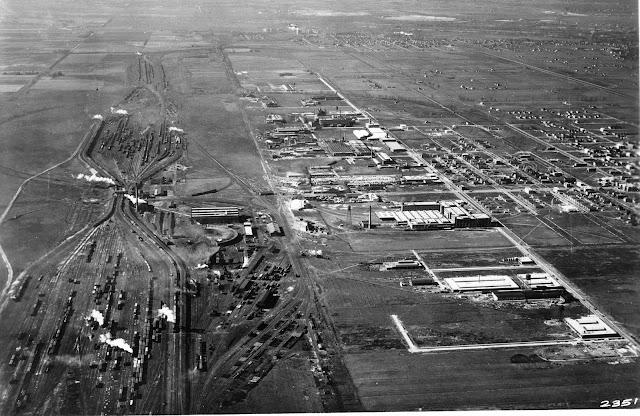 |
| Tommy Hill posted 1920's - Belt Railway of Chicago Clearing Yard looking straight west. For those familiar with the story of the Stickney Circle, you can see the outline of it in this photo. |
 |
| Cram, George Franklin; Murray-Aaron, Eugene, 1852-1941., Public domain, via Wikimedia Commons C Kent McKenzie commented on Tommy's post |
| BRC |
 |
| Max Armstrong posted This view is of the Bedford Park Yard (CSX RR) and the Clearing Yard (Belt RR). Lake Michigan is straight ahead, and Midway Airport is just out of view at about 9 o’clock. Downtown Chicago would be at about a distant 11 o’clock and Northwestern Indiana would be way out of view at about 2 o’clock. (Thanks to Southwest Airlines for another fine take-off.) [The intermodal yard is owned and operated by CSX.]
Just to the left would have been the old Johnson & Johnson plant where my Dad worked. It was next to the Cracker Jack plant on Cicero. I can still smell the aroma of carmel corn in my head!
C&EI Historical Society shared
Max Armstrong photo.
What's foamer.
Slang for a railfan. A railfan will spend a lot of time track side to get photos and/or videos of trains. Especially if they have an "interesting" locomotive leading the train. Sometimes they travel quite a distance to catch trains. I met one in Downers Grove IL that was from NYC to take videos of trains on the BNSF Racetrack. I think "foamer" was coined by railroad employees because railfans supposedly drool when they see a train coming. |
 |
| Sean Graham-White posted BRC Hump Tower interior - 9/25/05. Clearing Yard, Bedford Park, IL |
 |
| Sean Graham-White posted Circa July 1995 diagram of BRC's West Classification Yard. This is inside the Hump Tower. Bedford Park, IL |
 |
| IHAP: 19381129 |
Cicero Avenue has a long bridge over the yards. The traffic was stop-and-creep as I headed South. Since I had to make a left-hand turn at the end of the bridge, I was not in the right-most lane so this is the best picture I got.
| 20140906 0089c |
I then parked the car and walked South on the west side of the bridge. Unlike the Tollway Authority, the hand rails were high enough that I felt safe. And it is a good thing the sidewalk is wider than the Tollway Authority's design because this pedestrian crossing is used. I saw bikes and electric chairs, as well as regular pedestrians.
 |
| 3:28:12pm |
 |
| 3:28:46pm |
 |
| 3:29:36pm |
 |
| 3:29:40pm |
 |
| 3:29:42pm |
The south picture has two cabooses on the left and BRC engines 248, 585, 140 and 582. While studying the photo for the engines, I noticed that the train that is being humped hasn't even made it to the hump yet. So now I'm really surprised that it is going so slow. I include another shot because it has the three flat cars on the right. And the train appears to have reached the hump.
| 3:31:06pm |
I then concentrated on getting some pictures of a mother and slug. One last shot of the progress of the hump train. Judging from the curved track, it did about 4 car lengths in one and a half minutes. So it was going "fast" when it was shoving towards the hump and is now going even slower because it is humping?
A video is a little tedious to watch, but one thing that impressed me was
that he was evidently able to cross the street on the bridge. Traffic was backed up in both directions for the full length of
the bridge in the middle of the afternoon. What is the traffic like on this bridge during a rush hour? If you look at the map, this is one of the few north-south crossing for miles. (Central Avenue is closed under the hump to regular traffic! Railroads were a "paranoid" long before 9/11.) The traffic was so heavy on the bridge that there was no way I was going to cross the bridge in the middle to take decent pictures of the east side.
 |
| 3:32:42pm |
 |
| Glen Koshiol posted BRC 150T steam hook 190 was brought out this day to help in replacing the center plate on the turntable as some mechanical people look on. So the ALCOS were not the only equipment putting out smoke. My picture, 6/30/81. Phil Hosier: The E-L's derricks produced very little smoke and even less noise when opersating. Built in the 20's and still a marvel of smoothness and strength ! Mike Raia: I believe the wrecker is down in Monon, Indiana on display as a Monon wrecker. |
The remaining information until "Update:" is from a Sept. 2006 article in Progressive Railroading.
At the 650-acre Clearing Yard — a seemingly never-ending maze of 92 classification, 44 departure and 40 receiving tracks stretching several miles East and West of the tower — workers hump an average of two freight cars every minute of every day. To get 3,000 cars in and out of the yard each day and help keep traffic flowing through North America's largest rail hub, the more than century-old BRC needs to be a 24/7/365 operation.32 inbound and 33 output trains daily
They're also modernizing infrastructure and equipment, such as installing remote-controlled switches and implementing variable speed humping with help from Cattron-Theimeg Inc. and GE - Transportation.
If they execute the plan, they'll consistently process more than 3,000 cars within a 24-hour dwell period instead of the 26 or 27 hours the BRC has been averaging at times to switch 2,700 to 2,800 cars, managers say.
Re-humps because of incorrect humps are at about 15 percent of humps, which management considered too high. I was surprised that there were any incorrect humps. What goes wrong?
For the next six years, the railroad will be busy upgrading bridges, as well. Because most of its mainlines in Chicago are elevated, the BRC maintains 70 bridges, many of which were built in the late 1800s and early 1900s. The railroad will spend between $6 million and $7 million per year to rehabilitate about a dozen bridges and make the structures 286k-compliant, says O'Brien.
The same can't be said of a long-term investment in the BRC's locomotive shop. Built in 1914, the shop is used to service 650 of other railroads' locomotives a month, as well as maintains the BRC's 22 switchers — all of which employ locomotive remote-control systems — and five slug units. O'Brien wishes he had funds available to replace the facility.
"We want a new shop, but it would cost millions," he says.Now, workers at the facility repair about 1,200 cars a month, including the replacement of about 450 out-of-round wheels, says Superintendent of Mechanical O'Donnell.
Update:
 |
| Mike Wyatt -> Railroad Depots, Shops & Structures of North America Belt Railway of Chicago diesel shop. Built in 1914. Bedford Park, Illinois. December, 2015. |
 |
| David M Laz posted Bedford Il railyard James Karczewski In all the photos of the BRC yard you always know the place by the distinctive hump tower on the horizon. From the oldest to the newest. Nice picture. |
 |
| David M Laz posted Belt Railway of Chicago (BRC) Clearing Yard Chicago, (Courtesy Nicky Sudam) |
The following would be facing East. And it is just one of the two hump yards. The fact that there is no run-through tracks around it reminds me that in the first half of the century, freight moved in boxcars and had to be reclassified at the railroad yards. Probably only unit trains were stock-car trains, and they would have been taken directly to the stockyards rather than to this yard. It appears that his was taken before Midway Airport was built (dedicated in 1927) and shows that they did go way out of town to avoid property taxes.
 |
| David M Laz posted Fascinating from the are view of the early Clearing yard, originally run by The Belt Railway. The Belt has 28 miles of mainline route with more than 300 miles of switching tracks, allowing it to interchange with every railroad serving the Chicago rail hub. The Belt's Clearing Yards span a 5.5 mile distance among 786 acres, supporting more than 250 miles of track. Jerry Bragiel posted Old Round House Long gone, But Large Engine House Still In Operation Today, At The Belt's Chicago Clearing Yard |
 |
| Bob Lalich commented on above posting Actually the first Clearing Yard was owned, built and operated by Chicago Union Transfer Railway Co, which had no other track. It was promoted as a yard to sort cars for all the other railroads in Chicago. The location was chosen so that it would connect with the BRC and predecessors of the IHB and B&OCT. The first Clearing Yard design incorporated a giant circle of track with yards fanning off the circle. It was never completed but the circle was graded. Parts of the circle can be seen in this photo south of the west classification yard. CUT was acquired by BRC as part of the 1912 reorganization. |
A different exposure and better attribution of the photo posted by David Laz.
I learned from the following that the engine in the middle is Seaboard System, probably because it acquired the Monon route when it acquired the L&N.
 |
| BRHS posted
AN AIRPLANE VIEW OF THE CLEARING EAST CLASSIFICATION YARD, NEAR CHICAGO
This picture shows the layout of a modern classification yard. Two trains to be "broken up" and their cars made up into other trains may be seen in the foreground. the "hump" in on the near side of the little house spanning the tracks n the foreground, and the slope runs down into the yard. Up in this bridge house are men who operate electrically controlled switches. they press a given button, and the corresponding switch is set, and the cars intended for the train being made up on the track which this switch opens are uncoupled and allowed to roll by gravity to their appointed position. Clearing Yard, as a whole, is five miles long, contains 180 miles of track and 799 switches, and can handle 10,000 cars a day.
Photo and text from the April, 1923 edition of the National Geographic Magazine.
|
 |
| Eric Kruse posted At least three sets of power from three different railroads are sitting and waiting for their next train assignments at the Belt Railway of Chicago Clearing yard in Bedford Park, ill. on July 9, 1986 |
 |
| Michael DeSoi Sr. posted |
 |
| FlashOfGod Horace Bristol, An aerial view showing the Belt Railroad Clearing Yard, Chicago, 1941. History's Mirror posted The Belt Railway Clearing Yard in Chicago, captured in 1941 by photographer Horace Bristol for *LIFE* magazine, presents a powerful image of America’s industrial might during the World War II era. As one of the largest and busiest classification yards in the world, Clearing Yard served as a critical hub for freight traffic entering and leaving the Chicago area. Trains from all directions converged here to be sorted, assembled, and redirected, ensuring the efficient movement of coal, steel, food, and war materials across the nation. The photo likely shows an intricate web of switching tracks, smoke rising from steam locomotives, and workers braving the harsh environment to keep goods flowing. The scene is a reminder of Chicago’s pivotal role in America’s railroad system and the immense manpower behind its logistics network. In the 1940s, places like Clearing Yard were not just centers of commerce—they were arteries of the war effort and symbols of American resilience and industrial scale. Glen Koshiol: Looks like the east class yd. |
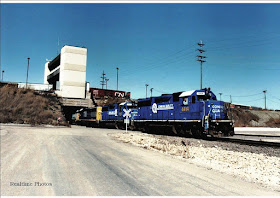 |
| Jake Jones posted Bedford Park IL June 2002 Under the double hump control tower. BRC yard [3D Satellite] |
 |
| Doug Kaniuk posted 10/28/2008, BRC Clearing yard from the Tower Ray Weart This view looks toward the East Class Yard in the afternoon. The Class Yard is on the right and the east hump approaches are on the left. |
 |
| Ray Weart commented on Doug's posting This is a view of a hump engine shoving the last of a cut cars over the west hump which humped into the East Class Yard 06-12-2012. |
 |
| Sean Graham-White posted A pair of BRC GP38-2s pushing cars over the hump into the East Classification Yard on 11/9/96. Bedford Park, IL |
 |
| Robert Kjelland posted Always get a window seat, and use it. Scott Malec This appears to be looking SE over Clearing into the CSX intermodal terminal and the industries along 73rd Street. Beyond that is Burbank where I grew up. |
 |
| a View of the Clearing Yard engine facility from the hump sometime in the early 90's. |
 |
| b An SP tunnel motor and a leaser pose with my old Firebird in this picture taken from the hump at Clearing in the early 90's. |
 |
| c CNW, UP, BN and BRC power at the Clearing engine facility taken from the hump in the early 90's. |
 |
| Glen Koshiol posted BRC 492/493 sitting between moves on the east hump. Taken from the old hump tower, my shot 3/78. |
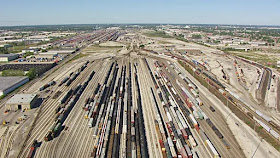 |
| Belt Railway of Chicago Clearing yard from RailwayAge |
 |
| John DeWit Woodlock II posted CNW 6809,6913 @ Clearing Yard-Bedford Park,IL 03 JUN 96. |
 |
| Sean Graham-White posted One of the great 'features' of BRC's Clearing Yard was the diversity of railroads and power that could be seen at the diesel shop. 4/23/14, Bedford Park, IL |
 |
| Global Earth Pro, 3/21/1999 |
 |
| Steven J. Brown posted Belt Railway of Chicago shops at Clearing Yard in Chicago - August 28, 1990. |
 |
| Dillon Harrison posted One of the perks of working for a Locomotive Service Contractor was the ability to take pictures in usually Off-Limits areas for the general public. I had many opportunities to get shots of Belt Railway equipment up close including inside the engine house at Clearing Yard in Bedford Park. This picture was taken back in February of 2016. The 312 being an example of the Belt’s “Newer” Power on roster at the time. The venerable 580 being one of the few remaining GP38-2’s on roster... |
 |
| Dillon Harrison posted
The Not-so-loved 200 series Belt Railway of Chicago Gensets resting inside the Engine house at Clearing Yard in Bedford Park. Taken February of 2016.
I will note that the Shop itself for being the age that it is, Is well maintained and kept relatively clean.
Mark Bilecki Sr. It always was taken care of, it is now 104 years old
|
 |
| Jeff Lewis commented on a BRC vs. UP Bailey Yard posting East bowl in the foreground, west bowl in the distance. Central hump bridge tower for both at the pinch point. Belt Railway Company of Chicago's Clearing yard is just as large, though not quite as long (we're talking half a mile because Bailey is spread out over more acres, not that those acres make up for more railroad), plus, Clearing has a double hump, employing the most sophisticated railcar sorting system in the world. Not to mention it handles more traffic. Ted Gregory posted the comment: One of the largest hump yards in North America, and I would say in the world. 250 miles of track, 786 acres. Double hump, double bowls, double arrival and double departure yards. Double hump operates in two different directions to two separate bowls (unlike CSX Rice Yard in Wax in which both hump tracks lead to one bowl) Dennis DeBruler UP's yard at North Platte, NE, looks like it could be bigger. https://www.google.com/.../data=!3m1!1e3!4m5!3m4... |
 |
| Casey Walker posted Always something to do at Clearing Yard. 10/6/18 |
 |
Joseph Kelly Thompson Flickr 2019 PhotoBRC 231 @ Bedford Park, Illinois
|
 |
| Sean Graham-White posted Going away shot at the Belt Railway of Chicago Hump Tower, Bedford Park, IL on 5/16/12 JR Partain: "Bring 'Em Up To The Top of the World" one of the yardmasters used to say... I can't remember his name... Craig Cloud: Take it fellow in neon vest RC operator for hump power? |
 |
| Sean Graham-White posted A Hump set of SD40-3/Hump Slug has just trimmed a track in the East Classification Bowl and is heading back towards the hump. Above the bowl in the background a cut of cars is being pushed for humping into the West Bowl. 5/16/12 Clearing Yard, Bedford Park, IL. Gary Talsky: Nice. But I take it not any public person could get this shot, right? Sean Graham-White: Correct |
 |
| Sean Graham-White posted Only at the BRC.... 6 (well OK, five) railroads in one shot. 9/12/96 at Clearing Yard's West Departure. From left to right: UP (CNW), BRC, UP, WC, WSOR, IHB |
%20Chicagoland%20Railfan%20_%20Only%20at%20the%20BRC...%20_%20Facebook.png) |
| Comments on Sean's post |
Gordon Smith posted six photos with the comment: "After checking out the west end of Clearning Yard, we decided to check out the engine facility (something I probably wouldn't try to do today). May 1993"
John Eagan: Be even more aware of trespassing after today [Nov 8, 2022]. In Illinois a new law allows trespassing to be a non-custodial arrest (certain restrictions apply) to be cited only. While citations have been issued for decades for this misdemeanor offense, the new law will make it easier for you to get a ticket. In other words, don’t trespass and risk a several hundred dollar fine.
 |
| 1 |
 |
| 2 |
 |
| 3 |
 |
| 4 |
 |
| 5 |
 |
| 6 |
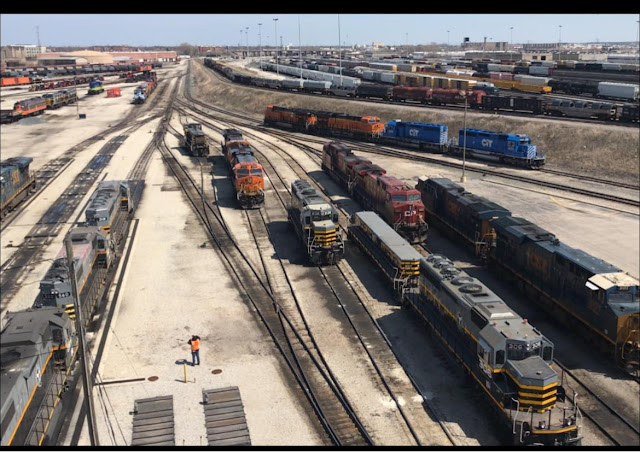 |
| Patrick McCarron posted BRC inbound service tracks. Photo taken from top of Diesel shop 10/6/21 |
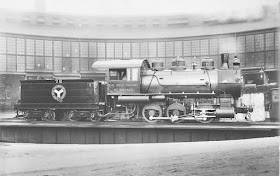 |
| BRHS posted
Belt Railway of Chicago 0-6-0 switch engine #72 at the Baldwin Factory in Pennsylvania - November 1905.
This engine was originally built for the Chicago & Western Indiana Railroad, but was sold to the BRC instead.
Dennis DeBruler It looks like the roundhouse in Clearing Yard. https://www.google.com/.../@41.7697507,-87.../data=!3m1!1e3 Andre Kristopans Belt Railway and C&WI were related entities. Locomotives were bought according to which pocket had money at the moment, thus who they were lettered for and used by and who bought them was not always the same. Alan Follett Andre Kristopans Obscure history: we certainly don’t think of the Belt as a passenger carrier, but in the early 20th Century they did run a very limited service between Clearing and C&WI’s Dearborn Station, mostly if not entirely for Clearing Yard employees. |
 |
| Satellite |
Sean Graham-White posted two photos with the comment: "Before AEI, the BRC had cameras along primary entrances/exits to Clearing Yard to record reporting marks of each train. Clerks would verify them to train reports that had been advanced from other railroads to ensure accurate car reporting and billing. Bedford Park, IL 7/1/95"
Richard Brunke: AEI was being used/tested/perfected long before 1985...try the 70's.
Sean Graham-White: Richard Brunke You are thinking of ACI - similar to a barcode, that was applied to the side of rolling stock. Photo was taken in 1995.
James Petrusek: When I worked there (2015-2017) we still had cameras to monitor near each AEI installation. The clerks would often still review the video to verify cars. Despite RFID, wheel sensors and a sonar presence detector, there still were errors. RFID tags would fall off, metal shavings and grease from flange lubricators would cause havoc with wheel detectors, or a good rain or worse, ice and snow would foul the presence detector horns. We had to do routine maintenance and lots of snow duty to keep them working.
Our biggest headache would be ballast or track crews might use a machine and break off the wheel detectors! Very frustrating.
Joseph Tuch Santucci: They used to have clerks at the entrances to the east and west receiving yards who did this the old fashioned way with paper and pencil. The conductors gave the clerks their trains’ waybills. The clerks would place the hand written lists and waybills into cylindrical containers and place them into the vacuum tube where they were zipped to the main office building just below the humps. These clerk jobs were eliminated with the cameras that were installed. Progress.
 |
| 1 |
 |
| 2 |
 |
| Sean Graham-White posted BRC Dispatcher's office way back in 12/20/1995. Bedford Park, IL Cory Behrendt: Interesting mix of old and (then) new tech. |
 |
| Rik Anderson posted SBD 7257 is at the BRC Clearing Yard in Bedford Park awaiting its next assignment on January 11, 1986. Rik Anderson photo. [This was back when railroads would do transfer runs to and from this yard.] |
 |
| Christopher Brandt posted I recently acquired this photo of the Belt Railway of Chicago. Any idea of where this pic was taken? Or the year it was taken? Dennis M Cisarik: The building to the far left is the maintenance of way building the next building going to the right is the storehouse along with the credit union and office of chief of motive power. The coach car is where we had safety meetings etc. The next building was where the company kept its records. They were stacked on shelves in hard covered books that were all handwritten in ink. There’s another building next to that record building that’s not in the frame was the laborer's locker room. William Garrett: You are correct the building was called the storage house my grandfather was the clerk there for many years William P Garrett retired in 1976 the storehouse clerk for many years. He started in 1926 as a male Clerk and worked his way up through the years making many friends with many people. Had a cousin named Jimmy Garrett who is also an engineer on top of the hump. |
 |
| Tom Lyons commented on Christopher's post I'm pretty sure it was taken right here, just south of the 392 Building and just East of the existing diesel shop. [https://maps.app.goo.gl/iEzJvoUF7ZYJ3qsY7] Ray Weart: Tom Lyons You're right, it was taken off the Diesel Shop building looking northeast toward the City. The yard in the background that has the N&W and PRR boxcars in it is the "District Yard" and has some signal stuff at the east end of it. This looks way different today. |
 |
| Bob Poortinga commented on Christopher's post I cropped it, fixed the perspective, and tuned it up a bit. |
 |
| 16:01 video @ 2:04 |
An Arturo Gross Flickr 1994 link of the west side with trains entering from Corn Products and from the BRC Union Station Branch was posted on Facebook.
Anthony Caciopo Wow, one of the old, rare ones with friction-journal trucks. No MU hookups, either. BRC sure was frugal ordering those. Hopefully, they came with a seat for the engineer.
David Daruszka When I worked at the IC we switched Corn Products. Did the Belt switch them as well?
Arturo Gross I recall seeing BRC jobs going from Clearing to the Argo plant, not sure if they did the switching or just transferred cars back and forth.
Bob Lalich According to the Ill. Freight Ass'n. Directory of Industries from 1963, Corn Products was switched by B&OCT, BRC, GM&O and IHB.
David Daruszka GM&O makes sense in that the IC job that I was on that worked at Corn Products worked out of GM&O's former Glenn Yard. I never realized the other roads worked the plant as well.
An Arturo Gross Flickr 1997 link: "BRC Alco C424s 601 and 605 drag a cut of cars towards the east end of Clearing Yard at Pulaski Rd in Chicago Apr 1997."
Arturo Gross Flickr 1998 Photo "GTW GP38-2 4931 and GP40-2 6408 keep company with a pair of BRC Alco C424s at BRC's Clearing Yard in Chicago in Apr 1998." with Willis/Sears tower in the background. (posted)
Hugh M Cook How many years did BRC get out of those C424s?
Arturo Gross More like 34, built in 1965, sold in 1999...
Bob Lalich Flickr 1994 Photo, two BRC Alcos smoking at Pullman Junction taking an empty coal train back to this yard.
Arturo Gross Flickr 1995 Photo, posted, Arturo Gross We're actually looking west here towards the hump, from under the south end of the Cicero bridge.
Mtnclimberjoe Rail Photography: "BRC 230 @ Chicago Clearing Yard
http://www.railpictures.net/photo/670239/"
I knew Clearing Yard blocks cars for a BNSF train to Galeburg. I learned from this post that they also used to create a BNSF train to go to the yard in Tulsa, OK (H-BRCTUL), but no longer.
Andrew Pine BRC has BNSF trains to/from Galesburg, Northtown, and Grand Forks and sometimes Aberdeen SD, La Crosse, and Kansas City
David Daruszka When I worked at the IC we switched Corn Products. Did the Belt switch them as well?
Arturo Gross I recall seeing BRC jobs going from Clearing to the Argo plant, not sure if they did the switching or just transferred cars back and forth.
Bob Lalich According to the Ill. Freight Ass'n. Directory of Industries from 1963, Corn Products was switched by B&OCT, BRC, GM&O and IHB.
David Daruszka GM&O makes sense in that the IC job that I was on that worked at Corn Products worked out of GM&O's former Glenn Yard. I never realized the other roads worked the plant as well.
An Arturo Gross Flickr 1997 link: "BRC Alco C424s 601 and 605 drag a cut of cars towards the east end of Clearing Yard at Pulaski Rd in Chicago Apr 1997."
Arturo Gross Flickr 1998 Photo "GTW GP38-2 4931 and GP40-2 6408 keep company with a pair of BRC Alco C424s at BRC's Clearing Yard in Chicago in Apr 1998." with Willis/Sears tower in the background. (posted)
Hugh M Cook How many years did BRC get out of those C424s?
Arturo Gross More like 34, built in 1965, sold in 1999...
Bob Lalich Flickr 1994 Photo, two BRC Alcos smoking at Pullman Junction taking an empty coal train back to this yard.
Arturo Gross Flickr 1995 Photo, posted, Arturo Gross We're actually looking west here towards the hump, from under the south end of the Cicero bridge.
Mtnclimberjoe Rail Photography: "BRC 230 @ Chicago Clearing Yard
http://www.railpictures.net/photo/670239/"
I knew Clearing Yard blocks cars for a BNSF train to Galeburg. I learned from this post that they also used to create a BNSF train to go to the yard in Tulsa, OK (H-BRCTUL), but no longer.
Andrew Pine BRC has BNSF trains to/from Galesburg, Northtown, and Grand Forks and sometimes Aberdeen SD, La Crosse, and Kansas City
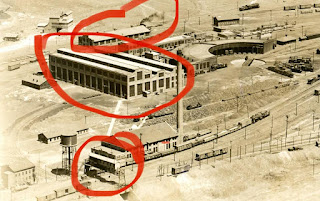

also if you take a look NS first reponders unit is present
ReplyDelete